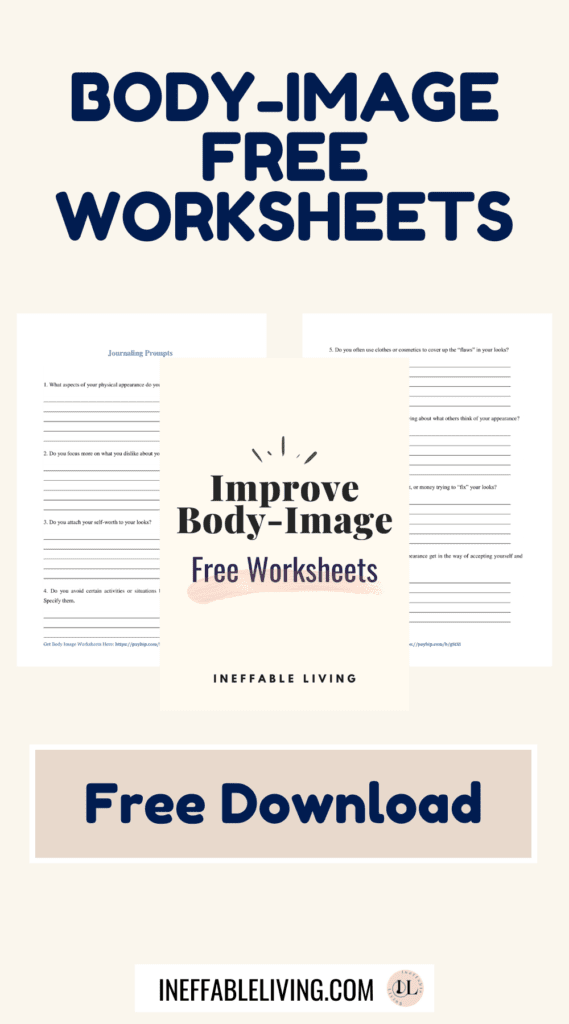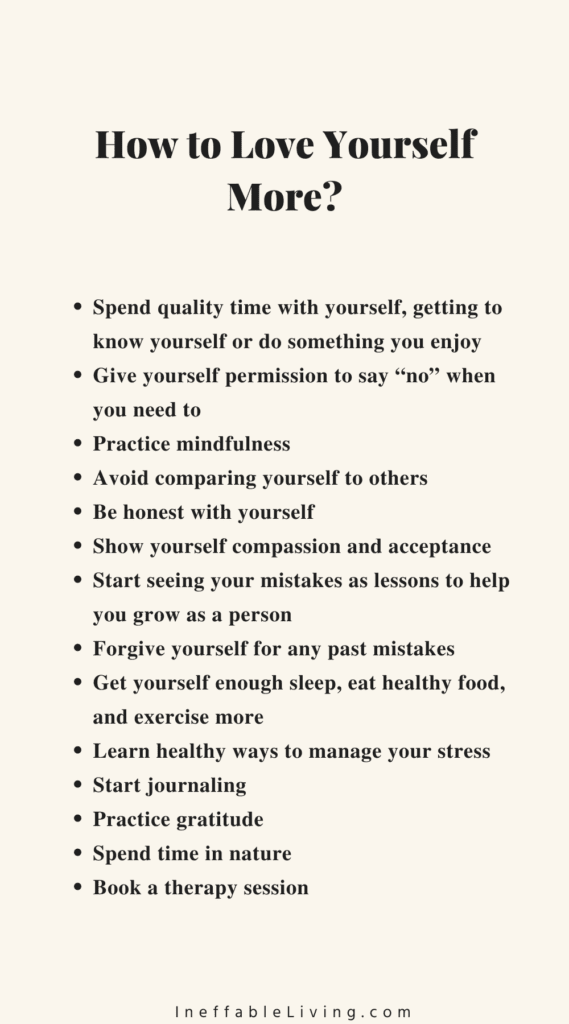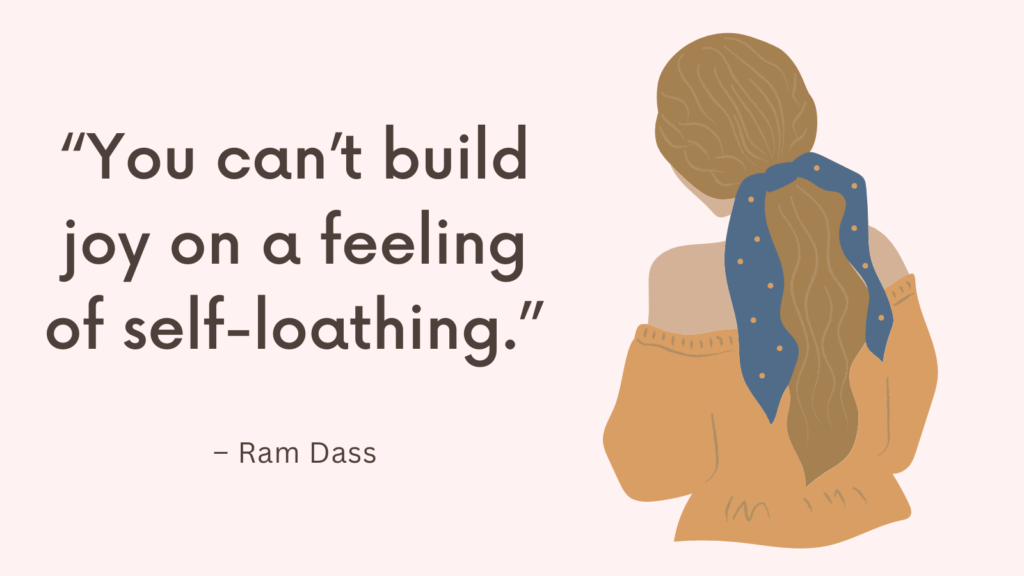Today, you’re going to learn all about distorted self-image and how to build a positive one.
What Is A Distorted Self-Image?
A distorted self-image refers to having a view of one’s self that is not based in reality.
For instance, we may believe that we’re thinner or heavier than we actually are.
However, when our self-imaged becomes significantly detached from reality, it can cause psychological problems among which is a disorder that’s called Dysmorphic Disorder (BDD).
The Anxiety and Depression Association of America describes BDD as: “BDD is a body-image disorder characterized by persistent and intrusive preoccupations with an imagined or slight defect in one’s appearance.
People with BDD can dislike any part of their body, although they often find fault with their hair, skin, nose, chest, or stomach. In reality, a perceived defect may be only a slight imperfection or nonexistent. But for someone with BDD, the flaw is significant and prominent, often causing severe emotional distress and difficulties in daily functioning.” (source)
Why Build a positive body image?
It’s been shown that the more invested people are in their appearance, the more they become preoccupied by it, devoting so much of their thoughts, emotions, energy, and behaviors to it.
How good they feel about themselves will be largely determined by how good they look at a given moment. This really means that they feel little self-worth.
Your body image has little to do with how you look and more to do with how you perceive the way you look.
Related: How Confident Am I Quiz (+Best 13 Practical Tools To Feel More Confident)
How To Fix A Distorted Body Image & Build A Positive One?
#1. Discover Your Body Image Strengths and Weaknesses
To improve your body image, you need to be fully aware of your own personal body image strengths and weaknesses.
Try answering the following questions:
On a scale from 0 to 5 with 0 being very dissatisfied and 5 being very satisfied, how satisfied are you with:
- Your overall appearance
- Your face (facial features, complexion)
- Your hair (color, texture, thickness)
- Your upper body (chest, shoulders, arms)
- Your waist
- Your lower body (buttocks, hips, thighs, legs)
- Your muscle tone
- Your weight
- Your height
#2. Become Aware of Your Negative Thoughts
One of the main reasons why you may be oblivious to your physical assets is that you are not aware of them, or maybe you push aside any self-affirming thoughts with a “Yes but …” followed by self-criticism.
For example, “I look good in this dress, but my hair is a mess.”
It’s also important to remind yourself that while you may worry about other people judging your appearance, they actually don’t judge you as harshly as you judge yourself.
Research shows that most people demand more physical “perfection” of themselves than they think others expect of them.
You may also believe that it’s vain and egoistic to think favorably of your looks. So whenever you mentally compliment yourself, you feel a brief guilt and dismiss the compliment with “I shouldn’t be thinking that.”
You need to acknowledge that self-criticism are not helping you feel better about yourself and you need to start giving yourself permission to acknowledge and enjoy your best features—without feeling guilt.
Whenever you’re about to dismiss a compliment, deliberately, practice indulging in it for a few minutes.
Related: 10 Powerful Techniques To Control Your Negative Thoughts
#3. Become Aware of Your Avoidance Behaviors
People use different ways to cope with struggles with their body image:
- Wearing loose-fitting clothing because you feel fat.
- Getting a new hairstyle or new outfit to improve your looks.
- Seeking reassurance about your looks from other people.
- Avoiding looking at mirrors or thinking about your body-image discomfort.
- Avoiding situations that might trigger your body-image discomfort, such as going to the gym or attending a beach party.
While most of these strategies sounds harmless, when you attach your worth and happiness to how good you look, they become toxic, further intensifying your dissatisfaction and preoccupation with your body-image.
In fact, dealing with body image discomfort by avoidance may provide you with temporary relief, but it reinforces your negative beliefs about yourself and perpetuates your body image difficulties.
Body-image discomfort is just a feeling that you can learn how be aware of and accept in a way that takes away its power rather than allow it to dictate what you do and how you think of yourself.
Related: How Do You Find Courage In The Face Of Fear? 9 Proven To Overcome Avoidance (& Live Fully)
#4. Define Specific Directions for Improvement
Using the previous steps, define specific directions for improvement.
For example:
- “I want to stop loathing my hair.”
- “I want to have fewer self-critical thoughts about my face.”
- “I want to allow myself to have positive thoughts about my best features.”
- “I want to become more comfortable with my looks at social events”
- “I want to spend less time trying to decide what to wear before going out.”
- “I want to quit comparing myself to women on Instagram.”
- “I need to eat healthy instead of starving myself.”
#5. Identify the Origins of Your Negative Body Image
Body image forms gradually, beginning in childhood.
A number of factors influence body image development, such as cultural forces, interpersonal experiences, and physical characteristics and changes.
These factors shape our body-image – the perceptions, beliefs, thoughts, and feelings we have around our physical appearance.
Many people who dislike their appearance can recall experiences of being criticized or teased as children because of their appearance.
How does identifying the origins of your negative body image help?
As a child, you might have adopted societal standards and ideals. It’s important to uncover them now that you can think for yourself, so you can challenge their validity.
Related: How to Challenge and Change Your Negative Core Beliefs?
#6. Mindfully Accept Your Body Image Experiences
Struggling with your body-image, probably lots of things trigger internal experiences concerning your appearance – memories, expectations, thoughts, feelings, and urges.
These inner experiences may be annoying, upsetting, or even painful. You may also think of them as truths or reality and you may even allow them to impact your mood and limit your life.
The key to deal with these experiences is to stop fighting them or feeding them and simply acknowledging them as what they are – an internal experience that passes by.
Acceptance here doesn’t mean you like these experiences or want more of them. It simply means that you refuse to give them power over you or let them dictate your thoughts and actions.
By accepting that you are experiencing a thought about your appearance, you take a step back to observe your inner experience and simply direct your attention and energy toward something else.
Try This: Body Scan
Mindfully, experience your body from the inside:
1. Find a comfortable place where you won’t be distracted.
2. Become aware of your breathing as you slowly breathe in and out. Notice your stomach rising and falling with each breath.
3. Become aware of your body. Notice how it feels where it touches your clothing.
4. Focus your attention on your feet. Feel the blood circulating there. If you cannot, just be aware that this is not your experience. That’s okay.
5. Slowly move your awareness to another part of your body.
If your attention drifts elsewhere, don’t judge it. Just notice it and then bring your attention back to the sensation.
This will help increase your awareness but also your acceptance.
You can also find opportunities throughout the day to become mindful of your body and notice different sensations, such as taking a shower, walking, washing the dishes, or washing your hands, eating, and making love.
#7. Face Your Mirror Reflection
Our experience of looking at our reflection in the mirror is usually biased.
If you have a negative body image, you’ll probably focus on “what’s wrong” with your looks and neglect your best features.
Your experience is also likely to be judgmental. You don’t just observe your reflection, you also evaluate and criticize yourself.
This is one of the main reasons people who struggle with negative body image avoid looking in the mirror. It triggers discomfort and can be very painful.
Although it might sound counterintuitive, the only way to change how you experience your body and reduce the discomfort is by facing your mirror reflection, according to many studies. (*)(**)
In fact, avoidance only perpetuates the problem and reinforces your negative beliefs about yourself.
Try This: Mirror Exposure
1. Dress normally when you first start practicing this and then wear more revealing clothes as you get more comfortable.
2. Use a full-length mirror where you won’t be interrupted.
3. Look at your reflection from head to toe, looking at each area from the front, side, and back, without zooming in on perceived imperfections or ignoring your best features.
4. Describe each aspect or feature of your body objectively and out loud, as you would to a blind person or an artist who is sketching you without seeing you.
5. Include descriptions of color, size, shape, etc. If you become aware of a judgment or criticism, pause and describe the feature again in an objective, factual way.
6. Be aware of any thoughts or feeling you experience and then simply shift your attention to the next area you will describe objectively.
7. Complete the practice by looking at your total reflection as a whole.
#8. Practice Mindful Self-Monitoring
To stop your negative emotions from controlling you, you need to take a step back and start examining your own thoughts in an objective way.
Throughout the day, start asking yourself the following questions:
- What am I feeling right now?
- What triggered this feeling?
- What thoughts am I having about this feeling?
- How am I reacting (or wanting to react) behaviorally to this feeling?
Answering these questions creates a space between you and your thoughts, allowing you to observe them without becoming over-identified with your feelings and thoughts.
#9. Challenge Your Appearance Assumptions
Appearance Assumptions are your core beliefs about the importance and impact of your looks on your self-worth and your life in general.
Most of us never stop to question the accuracy of these assumptions.
Some of the most common appearance assumptions most people have include:
- My worth as a person depends on how I look.
- The first thing that people notice about me is what’s wrong with my appearance.
- My looks are responsible for much of what happened to me in the past.
- If I can change my looks, I can finally accept myself and become happy.
By taking an honest look at these assumptions, you can challenge their validity and find a new inner voice that’s self-accepting and realistic.
Use the following questions to challenge your appearance assumptions:
· Do I have experiences that would contradict my beliefs in any way?
· What evidence do I have that what I believe is actually true?
· Am I falling into a thinking trap (e.g., catastrophizing or all-or-nothing treatment)?
· What would I tell a friend if he/she had the same thought?
· Am I confusing a belief with a fact?
· Am I basing my conclusion mostly on my feelings or on the true evidence?
Free Printable Worksheets For Body-Image (PDF)

#10. Consider New, More Realistic Beliefs About Looks
To help challenge your appearance assumptions, consider the following facts:
1. Action speaks louder than looks.
Traits such as warmth, intelligence, humor, honesty are highly valued and largely influence the way other people think of you.
Think about someone important in your life. How much do their looks influence the way you feel about them?
2. First impressions don’t last.
Our initial reaction to someone’s appearance changes overtime as we get to know the person they are.
Think of someone you met whose appearance wasn’t so appealing. How did knowing them change your first reaction to their looks?
“Beauty is all very well at first sight, but who ever looks at it when it has been in the house three days?”
– George Bernard Shaw
3. Showing your imperfections won’t stop people from liking you
Ask yourself how often you stopped liking someone or liked them less upon discovering some imperfection in their appearance, like a scar, or a pimple, or a few more pounds.
4. Physically attractive people are not necessarily happier than less attractive people.
Even good-looking people may struggle with accepting themselves and their body-image. Even though you might think of them as perfect, everyone can find a flaw in themselves.
That is to say that changing your looks, without changing your body-image – how you perceive yourself – won’t change the way you feel about yourself.
#11. Face Avoidance
In addition to practicing mindfulness and challenging your negative beliefs, you need to practice facing your body-image discomfort by doing the opposite of your urges.
For example, if you feel fat, rather than wearing loose-fitting clothes, wear something you like, regardless of whether it makes you look fat or not.
To help you face avoidance, use the following body and mind relaxation techniques:
1. Diaphragmatic Breathing
Under stress, your breathing becomes fast and shallow.
By deliberately breathing slowly and deeply, you counter this reaction and help yourself calm down.
- Inhaling silently through your nose as you count to four in your head.
- Then, hold your breath for a count of seven.
- Make a whooshing exhale from your mouth for a count of eight.
2. Muscle Relaxation
When you’re in distress, our mind sends messages that signal your muscles to contract.
By deliberately doing the opposite and relaxing your muscles, you send your mind that you’re not in danger, which then helps you calm down.
Start by contracting (tensing) and then relaxing your muscles, one set at a time:
(1) face and shoulders;
(2) arms, and hands;
(3) stomach;
(4) buttocks, thighs and feet.
Each time you relax your muscles, mentally repeat the phrase “let go.”
3. Mental Imagery
Shifting your attention away from distressing thoughts to pleasant ones can help calm you down.
Using your imagination, see yourself in a pleasing landscape, be it the beach, the mountains, the countryside, your childhood home—whichever pleases you most.
For a few minutes, allow yourself to engage your senses. Notice what you see, the sounds you could hear, the textures you can feel, etc.
Related: How to Defeat Social Anxiety and Build Confidence?

#12. Practice Positive Physical Experiences
Improve your relationship with your body by engaging in positive physical experiences.
These experiences include: physical health and fitness, sensate experiences, and appearance-oriented activities.
Examples of physical health and fitness activities include:
- Walking or running
- Swimming or surfing
- Playing a team sport like basketball, softball, football
- Ice-skating
- Lifting weight or working out on exercise machines
- Biking
- Gymnastics
- Yoga
- Dancing
Examples of sensate experiences include:
- Getting a massage
- Getting a manicure or pedicure
- Brushing your hair in a soothing manner
- Taking a relaxing bath
- Sunbathing
- Rubbing your body with lotion
Examples of appearance-oriented activities include:
- Getting a new haircut
- Getting a facial
- Wearing new clothes
- Putting on makeup
- Wearing perfume
- Wearing jewelry
- Whitening your teeth
- Getting a new haircut
- Getting a facial
- Wearing new clothes
- Putting on makeup
- Wearing perfume
- Wearing jewelry
- Whitening your teeth
Related: Top 45 Self Care Day Ideas at Home To Kickstart Your Self Care Ritual
Body Image Resources
Books
- More Than A Body By Lexie Kite, Lindsay Kite
- Wisdom of Your Body By Hillary L. PhD McBride
- The Body Image Workbook By Thomas Cash PhD
FREE Worksheets
- Body Image Worksheets Download PDF
- Body Shame Worksheets Download PDF
Quiz
TED Talk Body Image
- Enough with the fear of fat | Kelli Jean Drinkwater
- Body Positivity or Body Obsession? Learning to See More and Be More | Lindsay Kite
- Our bodies are not an image | Mary Jelkovsky
- Can Our Body Image Handle Social Media: Live Life Unfiltered | Keisha and Teagan Simpson

References
- Portions of this article were adapted from the book The Body Image Workbook: An Eight-Step Program for Learning to Like Your Looks, © 1997 by Thomas F Cash. All rights reserved.
- Body Image (nedc.com.au)
- Body Image | National Eating Disorders Association
- Body image: What is it, and how can I improve it? (medicalnewstoday.com)
- Body Image | Journal | ScienceDirect.com by Elsevier
- Body image | Office on Women’s Health (womenshealth.gov)
- (PDF) Body Image, Confidence, And Media Influence: A Study Of Middle School Adolescents (researchgate.net)
- Frontiers | Body Dissatisfaction, Importance of Appearance, and Body Appreciation in Men and Women Over the Lifespan (frontiersin.org)



